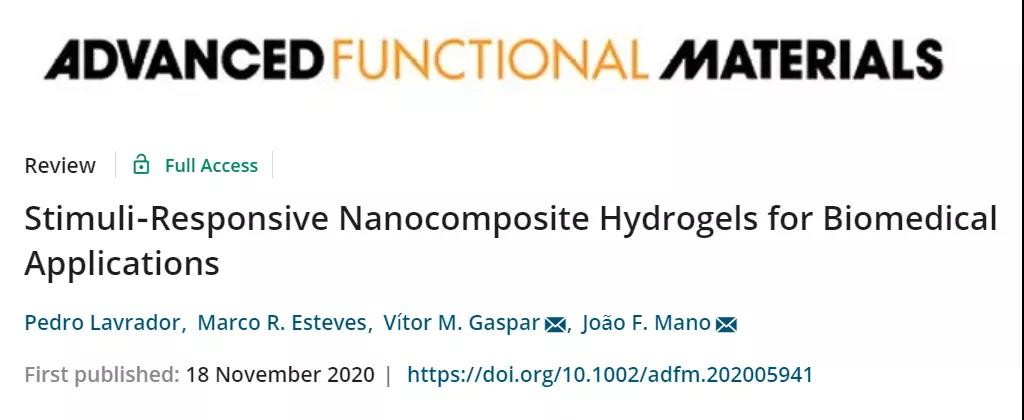
hotline:
17715390137
Tel/Wechat:
18101240246 (Technology)
0512-68565571
Email:mxenes@163.com (Sales Engineer)bkxc.bonnie@gmail.com
Scan the code to follow or search the official account on WeChat:
2D Materials Fronrier After paying attention,
click on the lower right corner to contact us,
Enter enterprise WeChat.
Professional Services Online

In medical field,when the vitality or integrity of tissue is affected by factors such as aging and injury, it is still extremely challenging to repair its biological function. In order to solve these problems, it is particularly important to seek more advanced bioengineering strategies to artificially imitate or even completely restore the functionality of natural tissues. Current biological materials are mainly presented in the form of membranes, sponges, fibers, hydrogels, micro-nano particles, etc. Among them, hydrogels and nanoparticles (NP) have received more attention due to the flexibility of structural design and stimulus-responsive programming .
In addition, although hydrogel can be used as a scaffold material to promote tissue formation and can reproduce the key features of natural extracellular matrix, its hydrophilic porous structure will significantly reduce the encapsulation performance of hydrophobic active ingredients and even fail to control drug release. Both hydrophilic/hydrophobic molecules have good sealing ability and can achieve a variety of stimulus responsiveness, but their non-specific accumulation in key parts and lack of physical support also limit the application of NP. Considering the advantages and disadvantages of the two materials, many studies have begun to combine hydrogels and NPs to prepare nanocomposite hydrogels, and add multiple stimulus response components to them to prepare complex bifunctional bodies. Based on this, Professor JF Mano of the University of Aveiro and others summarized the current research progress on nanocomposite hydrogels in the biomedical field, and summarized nanocomposite hydrogels with different response properties from the aspects of existence and application. Development.


Figure 1. The dynamic response process of the stimulus-responsive nanocomposite hydrogel to internal and external stimulus input. [Content interpretation] 1. Nanocomposite hydrogel design and assembly method Nanocomposite hydrogel refers to a hydrated polymer network containing nanomaterials, which can be assembled through non-covalent interaction or covalent connection. In the independent system, only one of the modules needs to interact with each other, and the other component is used as a network filling component to form a stronger system through self-crosslinking; while the assembly of the co-dependent system requires the interaction between hydrogel and NP, The resulting composite gel may be the addition or synergy of the two components. The assembly method of the composite system is usually divided into four types: (1) the hydrogel precursor is added to the pre-assembled NP suspension for cross-linking, so that the particles are pre-distributed in the scaffold; (2) the original hydrogel is cross-linked Positions form NP; (3) After the hydrogel is cross-linked, the pre-assembled nanoparticles diffuse inward; (4) The co-dependent hydrogel is assembled by using nanoparticles as a matrix/network cross-linking agent. 2. Stimulus response nanocomposite hydrogel design. The combination of NP and hydrogel can form a system with excellent performance, and the performance can be further expanded through stimulus response. Generally, the composite hydrogel can be decomposed into core components such as NP or hydrogel matrix, as the stimulus response or effect module in the material, and cause system changes in the form of output after recognition. In addition to responding to a single stimulus, biological systems can also be equipped with multiple receptors to respond to different stimulus inputs, and recognize and process different numbers of stimuli based on their composition as the initial input signal. The multi-component and hierarchical structure also facilitates the encoding of multiple stimulus responses by combining the hydrogel matrix and NP. The development of this multiple stimulus response system is essential to improve the sensitivity and compliance of drug transport in the body. In addition, similar to living cells, some NPs can also benefit their own transformation capabilities as intelligent transformation components, which connect multiple stimuli in an orderly manner through transformation nodes, and respond to many previously unrecognizable stimuli through NP stimulation sensors. Most of the current stimulus conversion nodes come from nanomaterials as natural stimulus sensors or NPs that can carry stimulus conversion characteristics. According to the identified stimulus, the response is divided into two modes, one-way and two-way.

Figure 2. Stimulus response nanocomposite hydrogel design strategy. 3. Biomedical properties of stimulus-responsive nanocomposite hydrogels Due to design flexibility and wide responsiveness to internal and external stimuli, nanocomposite hydrogels have significantly promoted the progress in the field of biomedicine. Common in vivo stimuli include responses to redox reactions, enzymes, glucose, temperature, pH, etc.; common in vitro stimuli include responses to heat, light, and magnetism.

Figure 3. Hyaluronic acid-based nanocomposite hydrogel utilizes the overexpression of hyaluronidase in infected wounds.

Figure 4. The on-demand drug delivery process of the magnetically responsive nanocomposite hydrogel. [Conclusions and Prospects] Compared with static platforms, stimulus-responsive nanocomposite hydrogels have more obvious advantages for the development of complex biological functional platforms. As described in this article, the combination of NP and hydrogel shows an excellent design And assembly flexibility, and the enhancement of biomedical performance. However, no matter how interesting its potential and development focus, this composite material has not yet been approved by the regulatory authorities for use in health care. How to overcome the barriers from the laboratory to the clinic is still a major challenge in research.
Original link: https://onlinelibrary.wiley.com/doi/10.1002/adfm.202005941
Information source: Frontiers of Polymer Science
This information is from the Internet for academic exchanges. If there is any infringement, please contact us and delete it immediately

| Reminder: Beijing Beike New Material Technology Co., Ltd. supplies products only for scientific research, not for humans |
| All rights reserved © 2019 beijing beike new material Technology Co., Ltd 京ICP备16054715-2号 |